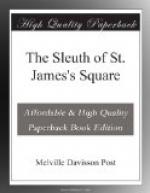“Sir Henry’s under jaw sagged a little. `Why, yes,’ he said, `that’s true; that’s precisely true. Gross, at the University of Gratz, determined that by experiment in 1912. I never thought about it!’
“`There are some other things here that you have not, perhaps, precisely thought about,’ Mr. Meadows went on.
“`For example, the things that happened in this room did not happen in the night. They happened in the day.’
“He pointed to the half-burned wax candle on the table. `There’s a headless joiner’s nail driven into the table,’ he said, `and this candle is set down over the nail. That means that the person who placed it there wished it to remain there — to remain there firmly. He didn’t put it down there for the brief requirements of a passing tragedy, he put it there to remain; that’s one thing.
“`Another thing is that this candle thus firmly fastened on the table was never alight there. If it had ever been burning in its position on the table, some of the drops of melted wax would have fallen about it.
“`You will observe that, while the candle is firmly fixed, it does not set straight; it is inclined at least ten degrees out of perpendicular. In that position it couldn’t have burned for a moment without dripping melted wax on the table. And there’s none on the table; there has never been any on it. Your glass shows not the slightest evidence of a wax stain.’ He added: `Therefore the candle is a blind; false evidence to give us the impression of a night affair.’
“Sir Henry’s jaw sagged; now his mouth gaped. `True,’ he said. `True, true.’ He seemed to get some relief to his damaged deductions out of the repeated word.
“The irony in Mr. Meadows’ voice increased a little. `Nor is that all,’ he said. `The smear on the floor, and the stains in which the naked foot tracked, are not human blood. They’re not any sort of blood. It was clearly evident when you had your lens over them. They show no coagulated fiber. They show only the evidences of dye — weak dye — watered red ink, I’d say.’
“I thought Sir Henry was going to crumple up in his chair. He seemed to get loose and baggy in some extraordinary fashion, and his gaping jaw worked. `But the footprints,’ he said, `the naked footprints?’ His voice was a sort of stutter-the sort of shaken stutter of a man who has come a’ tumbling cropper.
“The American actually laughed: he laughed as we sometimes laugh at a mental defective.
“`They’re not footprints!’ he said. `Nobody ever had a foot cambered like that, or with a heel like it, or with toes like it. Somebody made those prints with his hand — the edge of his palm for the heel and the balls of his fingers for the toes. The wide, unstained distances between these heelprints and the prints of the ball of the toes show the impossible arch.’
“Sir Henry was like a man gone to pieces. `But who — who made them?’ he faltered.




